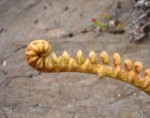Scientific Name: Sadleiria spp.
Endemic: All HI
Description: Commonly mistaken for hapu’u fern the easiest way to distinguish amau is from its new fronds that once unrolled are bright red then eventually turn green as they age. It also has more narrow frondlets which uncurl outwards unlike hapu’u which has more elaborate frondlets that they themselves look like individual fronds. The pulu on amau is more coarse and golen than the fine pulu of hapuu.
Distribution: There are several species of amau ferns that are endemic to all the main islands. In addition, there are two species that are found only on Kaua’i.
Cultural Uses: Occasionally in times of famine the starchy pith of ama’u was eaten just like that of hapu’u. A red dye was also extracted from the cortex of the trunk. The sap from within the rolled up fronds was used as a glue for binding and patching sheets of kapa. The fronds were also used as thatching the center ridge pole for waterproofing, or sometimes the whole house when pili wasn’t available.
Landscape Uses and Care: Ama’u look great in any landscape and can handle much more intense sun and drier conditions than hapu’u but still does well in partial shade too. Daily watering is needed once the plant is established then slowly reduce to a good soaking at least twice a week. Few pests bother this fern and once you have it growing you’ll be amazed.
Extra Info: Other names for amau include: mau, maumau, puaaehuehu, and amaumau. The main crater at Kilauea, Halemaumau literally means home of the amau since the crater and surrounding areas are loaded with them. The picture above is taken inside this crater.
Amau







